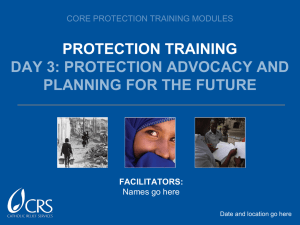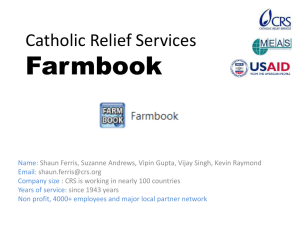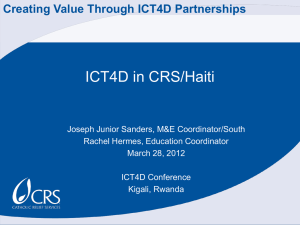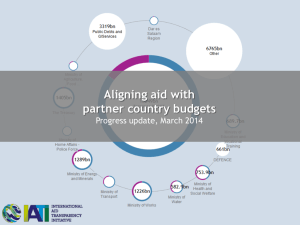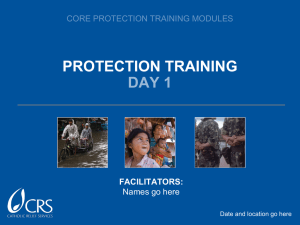PowerPoint slide deck for Day 2
advertisement
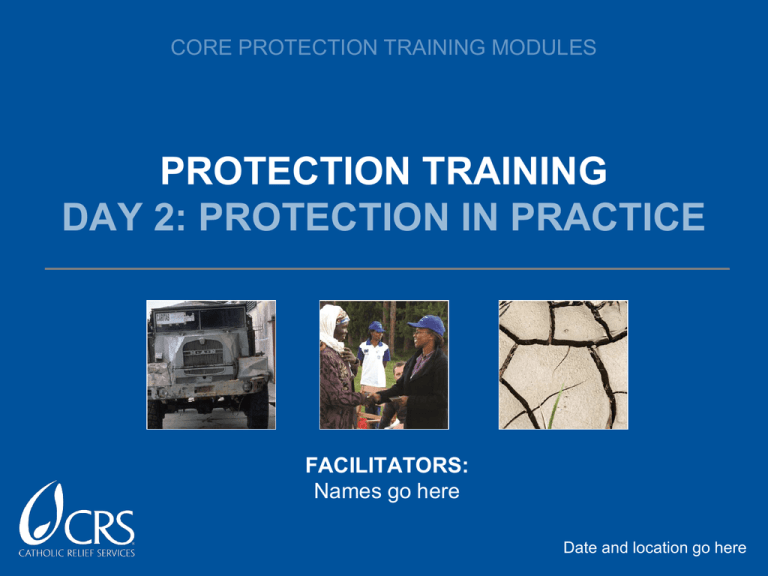
CORE PROTECTION TRAINING MODULES PROTECTION TRAINING DAY 2: PROTECTION IN PRACTICE FACILITATORS: Names go here Date and location go here TRAINING OUTLINE DAY TWO 09:00 – 10:40 Practical approaches to protection 10:40 – 11:15 Break 11:15 – 12:55 Protection programming 12:55 – 2:00 Lunch 2:00 – 3:50 Protection assessment 3:50 – 4:10 Break 4:10 – 6:00 Developing a Proframe CRS Core Protection Training Modules A FRAMEWORK FOR PROTECTION ACTIVITIES CRS Core Protection Training Modules 3 LEARNING OBJECTIVES Describe the aims, outcomes, and activities typical of a protection program; Integrate protection analysis into their assessment; Mainstream protection across CRS’ strategic programming areas, both emergency and non emergency; Describe how to gather data on sensitive issues like rape, GBV, abuses by public officials, etc.; Describe systems for keeping information confidential; CRS Core Protection Training Modules 4 LEARNING OBJECTIVES Strengthen analytical capacity and ability to manage sensitive data; Describe ethical and practical implications associated with sensitive data collection or the management of sensitive information; Apply knowledge of protection to design protection programs. CRS Core Protection Training Modules 5 FRAMEWORK FOR PROTECTION – EGG MODEL Spheres of Action Responsive Action (deal with the current abuse, aim at preventing, stopping, or alleviating its immediate effect) Remedial Action (subsequent action, restoration, rehabilitation, compensation) Environment-Building (create an environment conducive to full respect for the rights of the individual) CRS Core Protection Training Modules 6 MODES OF ACTION “Responsibilising”: working towards fulfilling legal obligations Persuasion Denunciation Mobilizing Substitution of services CRS Core Protection Training Modules Support to structures Direct services: working to provide assistance 7 FRAMEWORK FOR PROTECTION WORK MODES OF ACTION Persuasion: convincing authorities through private dialogue to fulfill their obligations and to protect individuals and groups exposed to violations; Denunciation: pressuring authorities through public disclosure into meeting their obligations and protecting individuals and groups exposed to abuses; Mobilization: sharing information in a discreet way with selected individuals, bodies, or states that can influence authorities to satisfy their obligations and protect individuals and groups exposed to violations; Substitution: directly providing services or material assistance to the victims of the violations; Support to structures and services: empowering existing national and/or local structures through project-oriented aid to enable them to protect individuals and groups. CRS Core Protection Training Modules 8 COMPLEMENTARITY MAPPING “RESPONSIBILISING” Denunciation Human rights report on violations Persuasion Negotiating access Workshop on IHL Food packages Teacher Training Substitution of services Implementing water system Support to structures DIRECT SERVICES CRS Core Protection Training Modules 9 QUESTIONS? CRS Core Protection Training Modules 10 ELEMENTS OF PROTECTION PROGRAMMING CRS Core Protection Training Modules 11 AIMS OF A GOOD PROTECTION PROGRAM Protection programs aim to change behaviors: Changing behavior of perpetrators Changing the actions of responsible authorities Reducing the vulnerabilities of affected communities CRS Core Protection Training Modules 12 SPECIFYING PROTECTION OUTCOMES Are positive and will genuinely improve people’s lives Are practical descriptions of achievable changes and improved conditions Will ideally address both threats and vulnerabilities CRS Core Protection Training Modules 13 A GOOD PROTECTION PROGRAM WILL… Be as participatory and complementary as possible; Be clear about its outcomes – select judiciously among the 5 modes of action; Be realistic in its assumptions of what our agency can and cannot change in the short, medium, and long term; Be complementary with others’ work so that the range of protection needs is covered; CRS Core Protection Training Modules 14 DESIGNING A PROTECTION PROGRAM Goal Strategic objectives Intermediate results Activities Outputs Outcomes ProFrame CRS Core Protection Training Modules 15 ASSESSMENT CYCLE Design/modify response Report conclusions CRS Core Protection Training Modules Identify information, needs, resources Collect data Analyze, interpret 16 RISK-BASED MODEL Risk = Threat + Vulnerability x Time The risk based model means appreciating the precise nature of the threats and vulnerabilities people are experiencing and the capacities they have to prevent and cope with them. This will lead to an analysis of what a programme might do to ‘fill the gap’ CRS Core Protection Training Modules 17 EXAMPLE: THREAT/VULNERABILITY Poor sanitation in the village force women and girls to use “open air latrines” in the nearby forest, exposing them to risks of being sexually harassed. And this could be the solution! CRS Core Protection Training Modules PROTECTION ASSESSMENT Understanding violations, threats, and perpetrators (involves collecting data) Assessing the impact of violations on protected people Understanding and mapping community protection strategies Identifying relevant legal standards and responsibilities Mapping political commitment and resources for protection CRS Core Protection Training Modules 19 RISK-BASED MODEL FOR PROTECTION ANALYSIS Reducing Threats Engaging those directly or indirectly responsible Reducing Vulnerabilities Engaging communities Reducing The Danger Time Limiting exposure to risks Recognizing Primary and Secondary Risks CRS Core Protection Training Modules 20 EXERCISE: 30 MINUTES In your small groups complete the threat and vulnerability analysis (on page X) in your workbooks for the sample case study. Record answers on a flip chart for feedback to plenary. CRS Core Protection Training Modules 21 EXERCISE: 30 MINUTES In your small groups develop a simple questionnaire for assessing the protection issues you identified in the threat and vulnerability analysis exercise. Record questions on a flip chart for feedback to plenary. CRS Core Protection Training Modules 22 QUESTIONS FOR PRIORITIZING A RESPONSE Which violations and threats – primary and secondary – are having the most devastating impact on individuals and communities? Which violations and threats are most prevalent and persistent? What are people’s greatest vulnerabilities? Which vulnerabilities is your agency best positioned to address? CRS Core Protection Training Modules 23 BASIC RULES FOR COLLECTING SENSITIVE DATA Confidentiality: Client confidentiality is essential, not only to protect the client but also to safeguard the integrity of the information and future data collection activities. Client must be free to withdraw consent from the interview at any moment without prejudice. Interview should be conducted in a manner that respects privacy and safety. Collected data should be coded and kept in a secure place. CRS Core Protection Training Modules 24 CULTURAL CONTEXTS Be aware of cultural and gender differences in verbal and non-verbal communication. Be conscious of your own body language and avoid intimidating gestures that will inhibit responses Dress appropriately Clarify concepts Language: ensure agreement or understanding of terms such as: “safety” – “gender” – “sexual violence” CRS Core Protection Training Modules 25 BEST PRACTICES Focus on safety, dignity, and integrity Think about law, violations, rights, and responsibilities Ensure respect Build on people’s own self-protection capacity Prioritize inter-agency complementarity and be realistic about our own agency/partners’ limits CRS Core Protection Training Modules 26 QUESTIONS? CRS Core Protection Training Modules 27

